Table of contents
- Technology: rear wheel The technology of the chassis and suspension
- Conventional swing arm
- Box swing arm
- Delta box swingarm
- Cast rocker arm
- Form sheet cast swingarm
- Deflection systems
- Path-dependent, progressive damping (PDS)
- Progression curves
- Maximum loads
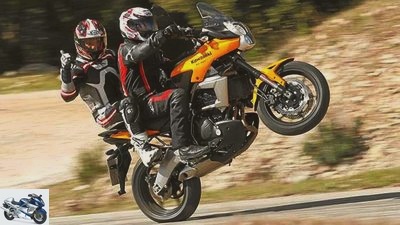
Bilski
counselor
technology & future
The technology of the chassis and suspension
Technology: rear wheel
The technology of the chassis and suspension
Motorcycle chassis must be equipped against all kinds of forces and bending moments. This is especially true for the highly stressed rear swing arm.
Werner Koch
01/20/2011
Half the world is happy when Karl and Liesel pack their seven things on their motorcycle: their children, because the booth is then free of storms, the neighbors because Karl’s dreaded barbecue party is canceled, and the tire dealer because Karl has to put on new tires after his motorcycle vacation. Only for the rear swing arm in Karl’s travel steamer is the whole thing no longer fun, because the fun-loving couple has nothing to do with diets, Liesel likes to pack the whole household except for the vacuum cleaner, and Karl quickly gets the Valpolicella supplies for the return trip in Bolzano the next barbecue party is stashed away. The bottom line is that half a ton, which Karl moves swiftly, does not stop at rough bumps and the battered swing arm almost straddles. why?
To answer this, we put a fully packed touring athlete (Suzuki Bandit 1250 S) on the scales and use the lever ratios to calculate which forces and moments the construction has to withstand; it is not just the heavy axle load of over 250 kilograms, but the extreme lever ratio between the rear wheel and the shock absorber that puts the bearings and swing bars to the point of bursting.
Buy complete article
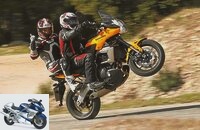
Technology: rear wheel
The technology of the chassis and suspension
4 pages) as PDF
€ 2.00
Buy now
Before doing this, however, let’s review the technical development of the rear suspension in fast motion. Until late in the 1970s, two struts at the end of the swing arm braced themselves against the weight of the horse and rider (see development of rear suspension). Arranged in this way, the rocker was almost free of any bending forces and only had to come up with a decent torsional stiffness (twist). Simple, one-dimensional constructions made of square or round tubes with play-free bearings and stable clamping of the rear wheel in the axle guides are sufficient.
The bending moments only changed dramatically with the introduction of central suspension with or without a reversing lever. Initially equipped with very simple structures made of extruded profiles (see photo on page 109, Suzuki GSX R 750), when the wide tires with more than 160 millimeters were introduced, the designers recognized that only a profile adapted to the course of the bending moment (see development of rear suspension center left , Yamaha FZR 1000 EXUP), which was able to guarantee the necessary rigidity with low weight at the same time.
As a result of this knowledge, the rear wheel swing arm mutated from a simple, inconspicuous component to a monstrous mountain range of often extremely elegant molded aluminum parts that would have looked good on many a GP racer (photo development of the rear suspension, bottom left, Honda CBR 1000 RR).
Nowadays, these handcrafted masterpieces are giving way to one- or two-part molds, some of which have sensationally thin walls. The elegance, however, falls by the wayside with the pimply cast surfaces. For this, such cast constructions are unbeatably cheap to manufacture (photo development rear wheel suspension center right, BMW F 800 R).
Back to the question of how the ton loads of a Bandit 1250 come together. With a swing arm length of 590 millimeters and a maximum static axle load of 270 kilograms, there is a lever ratio of one to 2.9 between the rear axle and the pivot point of the deflection. According to Adam Riese, this results in a load of 781 kilograms at the pivot point of the deflection bearing. Of course, when gliding elegantly over flat asphalt. But if Karl and Liesel thunders along with their Valpolicella supply on the dented Brenner motorway jagged towards home, there are 426 kilograms on the rear axle when accelerating fully and with a maximum dynamic axle load.
In this brief moment, a peak load of up to 1232 kilograms occurs at the pivot point of the deflection bearing. This corresponds to 2.6 times the gross vehicle weight of the Bandit 1250.
This extreme load can also be absorbed with a directly hinged shock absorber, but the extremely hard spring required makes it difficult to achieve a very high damping rate. All in all, a package that also causes problems in the coordination and extremely stresses the swing arm, which even led to breakage in the long-term test Yamaha XJ 600 S..
Things work much more smoothly if the shock absorber has more stroke and thus also needs a softer spring. And that is exactly what the deflection system makes possible. It reduces the leverage ratio to about two to one. That means: with 120 millimeters of spring travel on the rear wheel, the shock absorber is satisfied with a 60 millimeter stroke.
Due to the change in the lever position, the deflection systems also achieve a progressive spring / damper effect. An example: up to about half of the suspension travel, i.e. when the motorcycle rolls over the asphalt without great stress, the suspension responds softly and sensitively, because now the shock absorber with a short leverage has little stroke (five millimeters stroke with ten millimeters of suspension travel on the rear wheel ), and thus the spring is also compressed less strongly. If the motorcycle dips through a bump at the rear down to about 100 millimeters, the leverage decreases (progression). Then the damper piston and spring (6 mm stroke with 10 mm spring deflection on the wheel) must be subjected to more force. This progression (here 20 percent) protects against bottoming out of the suspension and stabilizes the motorcycle on undulating stretches or on sporty, brisk alternating curves.
Depending on the type of motorcycle and intended use, the progression curve is flat (light, mid-range machines) or strong (motocross machines). The fact that the rear wheel suspension is hardly immersed in modern motorcycles even when the front wheel is fully accelerated and the front wheel lifted is due to the inclined position of the swing arm and the arrangement of the chain drive. In combination, this results in a so-called pitch compensation, or anti-dive effect or anti-squad. But that’s a whole different story.
Conventional swing arm
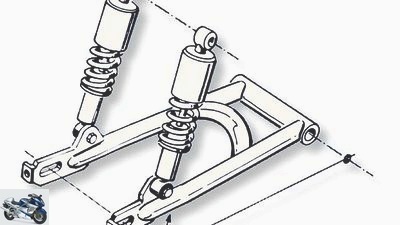
archive
Conventional swing arm
Until the mid-1970s, the two-arm swing arms of most motorcycles were supported by two shock absorbers mounted at the height of the rear axle. As a result, the one-dimensional swing body made of round steel was loaded with low bending and torsional forces and could therefore be built gracefully and lightly.
Box swing arm
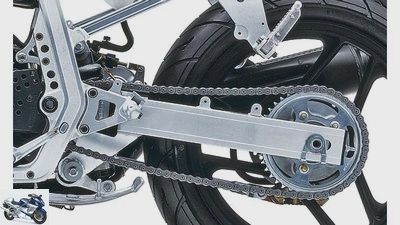
archive
Box swing arm
With the first central suspension, in the picture the Suzuki GSX-R 750 R from 1985, more stable aluminum rectangular profiles with a large cross-section and profiled walls should be able to cope with the bending forces between the rear axle and the strut without increasing the weight. This did not always succeed with the often undersized components.
Delta box swingarm
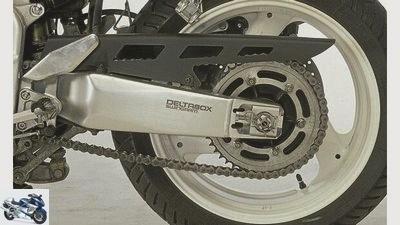
archive
Delta box swingarm
Yamaha consistently implemented the trend towards stiff aluminum construction by adapting the cross-sections of the FZR 1000-EXUP swingarm to the bending curve: small cross-section on the rear axle, large cross-section at the front of the strut.
Cast rocker arm

archive
Cast rocker arm
Usually made from one casting, this design dramatically reduces costs. The cast swingarm of the BMW F 800 R only needs to be machined at the pivot and attachment points. No welding or straightening work. Exceptions: high-quality constructions optimized with additional aluminum sheets such as this Ducati single-sided swing arm with a large clamping fist for the wheel axle eccentric.
Form sheet cast swingarm

archive
Form sheet cast swingarm
Inexpensive cast parts, stable extruded profiles, twisted swing arm bearing tube and brushed molded sheet metal parts with high-quality optics made it possible to mass-produce beautiful asymmetrical components like this swing arm of the Honda CBR 1000 RR. More lightweight construction with maximum stability is hardly conceivable.
Deflection systems
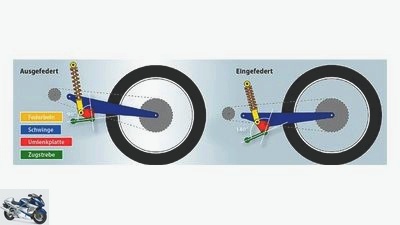
Drawing: archive
The spring angle.
Functional principle of the deflection
With the deflection system, the engineers try to equip the rear suspension with a more or less strong progression. For this purpose, a deflection plate (red) is used between the spring strut (yellow) and the rocker arm (blue). On the sketch you can see that the tension strut (green) engages the deflection plate in the extended state at a 90-degree angle (longest possible lever arm). During the compression process, the angle increases to around 140 degrees, the lever arm is shortened by around 30 percent, creating a progressive characteristic curve for the spring system.
Path-dependent, progressive damping (PDS)
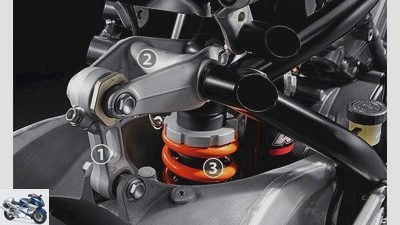
archive
The push rod (1) actuates the spring strut (3) of the KTM RC8 via the rocker (2).
For years, KTM has relied on directly hinged struts, which, however, have integrated progressive damping and progressively wound springs, technical term: Progressive Damping System. However, at KTM, too, the trend in motocross and on the road is towards tried-and-tested deflection systems.
Progression curves
Conventional systems with two struts have a linear curve. A relatively flat progression curve is usually used for light middle-class and sports machines. Only with motocross machines does the progression curve increase extremely with increasing spring travel. This guarantees a sensitive response behavior on small bumps and at the same time protects the driver and material from brutal bottoming out after high jumps.
Maximum loads
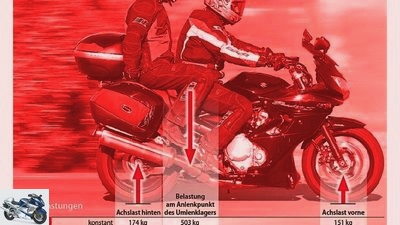
archive
The loads on the axles.
Depending on the design and spring system, more or less high bending forces arise on motorcycle swing arms. Touring machines in particular with a full load and a high dynamic axle load distribution on the rear axle place extreme demands on the swing arm and spring system. Important: When fully loaded, increase the spring preload in order to avoid bottoming out of the suspension and thus extreme load peaks. Damage such as the broken strut eye of the Yamaha swing arm can thus be avoided.
Related articles
-
ZF equips Betamotor off-road bikes with chassis technology
beta accesories landing gear & Spring elements ZF equips Betamotor off-road bikes with chassis technology ZF equips off-road bikes Beta engine: perfectly…
-
Chassis special part 1: motorcycle suspension
fact accesories landing gear & Spring elements Chassis special part 1: motorcycle suspension Chassis special: suspension Everything about motorcycle…
-
counselor technology & future Rear suspension Rear suspension Rear suspension The first motorcycles had a rigid rear suspension. Since bumps in the road…
-
Suspension special: Part 7 – rear
archive accesories landing gear & Spring elements Suspension special: Part 7 – rear Suspension special: rear Does the motorcycle drive strange lines?…
-
Swing geometry and suspension behavior
Drawing: MOTORCYCLE motorcycles Swing geometry and suspension behavior Swing geometry and suspension behavior Chain reaction Full steam ahead, the chain…
-
WP Suspension new road chassis
WP suspension accesories landing gear & Spring elements WP Suspension new road chassis WP Suspension Apex Pro and Xplor Pro New chassis for street bikes…
-
Technology: suspension and chassis
fact accesories landing gear & Spring elements Technology: suspension and chassis Technology: suspension and chassis New trend: Big Piston Fork New trend…
-
PS reader question about motorcycle technology
jkuenstle.de counselor technology & future PS reader question about motorcycle technology PS reader question about motorcycle technology Beam or banana…
-
accesories landing gear & Spring elements Basic chassis set-up Basic chassis set-up Basic chassis set-up The chassis tuning begins with the inspection of…
-
Suspension guide – correctly adjusting the damping, part 1
Photos: fact accesories landing gear & Spring elements Adjusting suspension / damping correctly, part 1 Guide: Adjusting the suspension / damping…